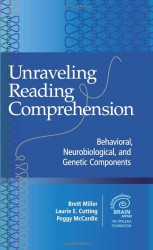There’s a lot more to reading than our ABCs—we need to be able to glean information from texts. Differences in the ways children learn to read mean there is a broad range of abilities in the general population, and many children have difficulty understanding what they read. With reading ever more important in our information-rich world, helping struggling readers increase comprehension is crucial.
Scholars from multiple disciplines, including several from Vanderbilt University’s Peabody College of education and human development, contributed to the recently published research volume, Unraveling Reading Comprehension: Behavioral, Neurobiological, and Genetic Components (Brookes Publishing).
Part of the Dyslexia Foundation’s Extraordinary Brain Series, the book explores science and theory, effective instruction, and priorities for future research for helping all students become more-confident readers. Chapters are drawn from papers delivered at a 2012 Dyslexia Foundation symposium, the first to focus explicitly on reading comprehension, which Peabody professor Laurie Cutting and Brett Miller, health scientist administrator for the National Institutes of Health (NIH), directed.

“Research has established that there are multiple critical components associated with reading comprehension, including but not limited to decoding and word recognition, linguistic proficiency, working memory, background knowledge and higher thinking skills, such as those commonly labeled as within the rubric of executive function,” said Cutting, the Patricia and Rodes Hart Professor of Special Education, Psychology, Radiology and Pediatrics.
“Readers not proficient in one or more of these areas may have poor reading comprehension. Dyslexia, for instance—one of the most well-researched types of reading difficulties—is characterized by poor word-level processing. Without being able to decode, it’s difficult to be able to comprehend text.”
Access to reading instruction and reading materials affect a child’s developing neurocognition. Comprehension depends on multiple sources of knowledge and the processes that use such knowledge. A greater grasp of those processes, the authors argue, can lead to better understanding of reading comprehension difficulties and improved interventions to help children and adults who struggle with text in everyday life.
For example, a chapter on using advanced statistical modeling demonstrates a relatively new analytic technique to examine individual differences in reading comprehension skill related to the reader, the text, and reader-text interaction.
“We highlight one of these techniques—item response random effects modeling—which allows us to explain variability in reading comprehension,” said Peabody Professor of Special Education Donald Compton, one of the chapter’s authors. “Our hope is that these models will motivate researchers to explore important questions about person and text that affect reading comprehension.”
The volume explores the behavioral, neurobiological, and genetic components of reading comprehension. Contributors posit that there is a range of causes of reading disability, among them poor working memory, poor cognitive control, deficits in oral language, problems understanding relationships between meanings of words, specific language disorders often coincidental with dyslexia, or failures to make inferences or monitor comprehension. To address these difficulties, they present findings on:
- the trajectory of reading skill development
- causes of comprehension problems during reading
- ideal characteristics of effective reading comprehension assessments
- new analytic techniques that examine individual differences in comprehension skills
- groundbreaking behavioral genetics studies examining reading comprehension
- distinctions between oral comprehension and reading comprehensionl
- how various text types interact with the cognitive and neurobiological profiles of children with varying comprehension abilities
- interventions for diverse learners who struggle with comprehension, and
- intensive interventions for adolescents with dyslexia
“Further developing multidisciplinary teams and data sharing will be increasingly important to understanding why so many struggle with reading comprehension,” said Cutting, who edited Unraveling Reading Comprehension with Miller and Peggy McCardle of NIH. “Combined with innovative emerging technologies, researchers in education, psychology, speech and language, cognitive neuroscience, genetics and computation could each contribute greatly.”
